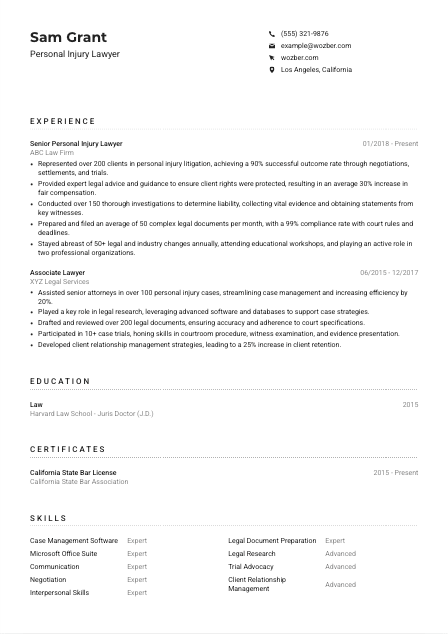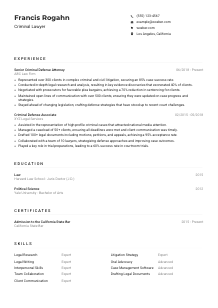Personal Injury Lawyer Resume Example
Fighting for justice, but your resume feels bruised? Examine this Personal Injury Lawyer resume example, reconstructed with Wozber free resume builder. See how effortlessly you can present your litigation prowess to align with job requirements, ensuring your legal career stays in top form, minus any objectionable details!

How to write a Personal Injury Lawyer Resume?
Hello, aspiring Personal Injury Lawyer! Are you ready to stand out in the competitive legal field and secure your dream job? It's time to take your resume from good to great with precision and a touch of legal flair. Using Wozber's free resume builder, this guide is crafted to help you transform your resume into a powerful tool that resonates with hiring managers. Let's dive into creating a resume that not only meets but exceeds job expectations.
Personal Details
The Personal Details section is your opening statement. It's where you set the tone and make your first impression, much like an opening argument in court. Let's ensure this section is impactful and precisely aligned with what a Personal Injury Lawyer position demands.
1. Name It Out Loud
Your name is not just an identifier; it's the title of your professional story. Use a clean, professional font that stands out because this is your brand. A Personal Injury Lawyer's name commands attention, so make sure yours does too.
2. Title Connection
Directly beneath your name, place the title 'Personal Injury Lawyer' as it closely mirrors the job you're aiming for. This straightforward strategy informs hiring managers that you're not merely applying; you're answering a specific call to serve justice.
3. Essential Contact Info
In the world of personal injury law, being accessible is key. Ensure your phone number and professional email (preferably firstname.lastname@email.com) are correct. A slight typo could mean a missed opportunity to connect.
4. Local Champion
Since location is crucial, especially for court appearances and client meetings, stating "Los Angeles, California" directly matches one of the essential job requirements. It tells your future employer you're ready and available where you're needed most.
5. Show Your Professional Face
If applicable, adding a LinkedIn profile or personal website dedicated to your professional achievements can offer deeper insights into your legal prowess. Ensure these profiles are polished and mirror the achievements and qualifications on your resume.
Takeaway
Remember, the Personal Details section is your resume's handshake—a professional and precise introduction. It's the first checkpoint in showcasing your readiness. Keep it aligned with your career goals as a Personal Injury Lawyer. Now, let's move to building your professional narrative.





Experience
In the legal world, your experience speaks volumes. For a Personal Injury Lawyer, it's about showing not just where you've been, but the battles you've fought and the victories you've secured. Let's tailor your experience section to showcase your track record and expertise.
- Represented over 200 clients in personal injury litigation, achieving a 90% successful outcome rate through negotiations, settlements, and trials.
- Provided expert legal advice and guidance to ensure client rights were protected, resulting in an average 30% increase in fair compensation.
- Conducted over 150 thorough investigations to determine liability, collecting vital evidence and obtaining statements from key witnesses.
- Prepared and filed an average of 50 complex legal documents per month, with a 99% compliance rate with court rules and deadlines.
- Stayed abreast of 50+ legal and industry changes annually, attending educational workshops, and playing an active role in two professional organizations.
- Assisted senior attorneys in over 100 personal injury cases, streamlining case management and increasing efficiency by 20%.
- Played a key role in legal research, leveraging advanced software and databases to support case strategies.
- Drafted and reviewed over 200 legal documents, ensuring accuracy and adherence to court specifications.
- Participated in 10+ case trials, honing skills in courtroom procedure, witness examination, and evidence presentation.
- Developed client relationship management strategies, leading to a 25% increase in client retention.
1. Dissect Job Necessities
Start by identifying key responsibilities from the job description, such as 'represent clients in personal injury litigation' or 'conduct thorough investigations.' These phrases become your keywords and guiding stars for what to include.
2. Role and Setting
Structure your work history to spotlight your evolution in the field. Highlight your role, the firm, and the duration. Recency adds relevance, so your current or most recent position takes precedence.
3. Targeted Achievements
Each role you include should feature accomplishments that mirror the position's needs. For a Personal Injury Lawyer, detailing success rates, client compensation increases, or notable settlements will speak directly to your capabilities.
4. The Power of Numbers
Quantifying your success offers tangible evidence of your impact. A mention of 'Represented over 200 clients with a 90% successful outcome rate' adds weight and showcases your efficiency and efficacy in the field.
5. Relevant Focus
While all experiences shape us, prioritize those that align with personal injury law. Each detail should be a testament to your skills and dedication in this particular specialization, steering clear of unrelated roles.
Takeaway
Your experience section is your courtroom where you present evidence of your prowess. Use it to convey not just what you've done, but how well you've done it. Let's proceed to outlining your educational foundation, another cornerstone of your career.
Education
For a Personal Injury Lawyer, education is where you've laid the groundwork for your legal journey. This section should reflect not just where you've studied, but the magnitude of your commitment to law.
1. Resonate with Job Specs
Pinpoint and highlight the educational criteria mentioned in the job listing, such as a 'Juris Doctor (J.D.) degree from an accredited law school required.' This directly aligns your qualifications with what the firm is seeking.
2. Clear Structure
Maintain clarity and conciseness. List your degree, followed by the field of study, the institution's name, and your graduation year. For a seasoned lawyer, this straightforwardness respects the hiring manager's time and focuses on the essentials.
3. Tailoring Your Academic Story
If your degree directly reflects the position, like a Juris Doctor for a Personal Injury Lawyer, make sure to clearly state this. For roles seeking specific areas of law, highlighting relevant coursework or specializations could be beneficial.
4. Coursework and Achievements
Though your degree speaks volumes, additional courses or distinctions can complement your narrative. If you've specialized in courses such as 'Torts Law' or 'Civil Procedure,' mention these to further establish your suitability.
5. Educational Honors
Include any honors, scholarships, or recognitions that set you apart. As you progress in your career, these become testimonials to your dedication and capability from the outset.
Takeaway
Your educational section builds trust in your foundational knowledge and specialized training. Now, let's enhance your profile with certifications that shine a light on your ongoing commitment to excellence.
Certificates
In the field of law, continual learning and attestation to your expertise are key. Certifications can highlight your dedication to keeping current and deepening your knowledge.
1. Match with Job Essentials
First, highlight any certifications explicitly mentioned or highly relevant to a Personal Injury Lawyer. While the job description may not specify, holding a 'California State Bar License' is non-negligible and speaks to your credibility.
2. Relevance is Key
Prioritize certifications that have the most impact on your role. For example, courses on advanced negotiation or specific legal software proficiency underline your capabilities and preparedness.
3. Dates Matter
Including acquisition or renewal dates, especially for your bar license, assures firms of your current standing and commitment. This adds a layer of trust to your candidacy.
4. Stay Proactive
The legal landscape is ever-changing. Showcasing recent certifications or ongoing educational pursuits demonstrates your initiative to stay ahead, making you a valuable asset to any team.
Takeaway
Highlighting pertinent certifications emphasizes your journey of continuous improvement. As you adapt and grow, so does your appeal to potential employers. Let's move forward to emphasize the toolkit you bring to the table - your skills.
Skills
In your resume, the skills section is where you crystallize your legal talents and professional abilities. Let's delineate the skills that are particularly coveted for a Personal Injury Lawyer and how to present them effectively.
1. Extract and Match
Gleaning both explicit and implicit skills from the job description can ensure this section aligns perfectly with the employer's needs. Case management software proficiency and strong negotiation skills are key for a Personal Injury Lawyer.
2. Direct Alignment
Emphasize those skills that are directly mentioned or implied in the job description, such as negotiation and communication. Highlighting expertise in legal research can set you apart in the field.
3. Organization and Precision
List skills in an organized manner, focusing on those that establish your value as a Personal Injury Lawyer. Remember, quality over quantity ensures a powerful impact and makes for an easier read.
Takeaway
Each skill you list is a testament to your capability and potential. Make this section a compelling aspect of your personal brand. Let's now look at how multilingual capabilities could enhance your appeal in the diverse legal landscape.
Languages
The ability to navigate multiple languages can be a significant asset in the diverse world of law. For a Personal Injury Lawyer, this might mean broader client communication and understanding. Here's how to highlight your linguistic skills.
1. Identify Job Language Needs
"English language skills essential" is a clear mandate from the job description. Ensuring your proficiency is prominently listed reflects an immediate qualification.
2. Prioritize Important Languages
Starting with English as 'Native' showcases that you can effortlessly communicate, both orally and in writing. This is fundamental for client interactions, courtroom advocacy, and legal document preparation.
3. Showcase Additional Languages
Being fluent in Spanish, as the resume example shows, can be particularly valuable in diverse communities like Los Angeles. It speaks to your ability to connect with a broader clientele.
4. Honesty in Proficiency
Clearly defining your language proficiency level is key. From 'Fluent' to 'Basic,' being honest about your language skills sets clear expectations and builds trust.
5. The Role's Scope
Understanding the geographical and cultural context of where you'll be practicing can help prioritize which languages to feature. In multicultural hubs, additional languages can be a significant asset.
Takeaway
Languages do more than just communicate; they connect. In a role as crucial as a Personal Injury Lawyer, your ability to speak various languages can significantly broaden your reach and impact. Now, let's craft a summary that encapsulates your legal expertise and readiness.
Summary
A compelling summary is your chance to encapsulate your professional journey and ambition in a few powerful sentences. For a Personal Injury Lawyer, this is where your passion for justice and your legal acumen converge. Let's make it count.
1. Grasp The Job's Core
Understanding the essence of the job helps tailor your summary to speak directly to the hiring manager's needs. Highlighting a '90% successful outcome rate' and 'expertise in legal research and trial advocacy' directly matches the job's call to action.
2. Professional Snapshot
Begin with a broad statement about your profession and experience that instantly communicates your value proposition, such as a proficient Personal Injury Lawyer passionate about securing clients' rights and fair compensation.
3. Mirror Job Requirements
Addressing explicit skills and accomplishments demanded by the job description establishes a direct relevance. Your specialized experience in personal injury cases and successful advocacy tells employers you're the right fit.
4. Conciseness is Key
Keep your summary focused and impactful. This isn't the place for the minutiae of your career but rather a billboard showcasing your highlights and what you bring to the table.
Takeaway
This section is more than just a summary; it's your pitch, an opportunity to distinguish yourself. Craft it with care, focus on your strengths, and directly align it with the role you're targeting. Your Personal Injury Lawyer resume is now courtroom-ready, and you are set to make a powerful case for your candidacy. With Wozber's tools, including the ATS-compliant resume and ATS resume scanner, you're equipped to tailor your resume perfectly. Dive into Wozber's free resume builder, and let's secure that role you've been aiming for!
Launching Your Personal Injury Lawyer Journey
Congratulations, you've meticulously crafted each section of your Personal Injury Lawyer resume with dedication and expertise. Your resume is not just a document; it's a testament to your commitment, skills, and readiness to advocate for those in need. Remember, every case is unique, and so are you. Leverage Wozber's free resume builder, ATS-friendly resume templates, and ATS resume scanner to ensure your resume is not just seen but remembered.
Your journey to becoming an influential Personal Injury Lawyer has been set in motion. The courtroom awaits your prowess. Let's make your mark and fight for justice, one case at a time.

- Juris Doctor (J.D.) degree from an accredited law school required.
- Admission to the state bar association and in good standing with no disciplinary action.
- Minimum of 5 years of experience handling personal injury cases, with a proven track record of successful outcomes.
- Strong proficiency in legal research, case management software, and Microsoft Office Suite.
- Exceptional communication, negotiation, and interpersonal skills.
- English language skills essential.
- Must be located in or willing to relocate to Los Angeles, California.
- Represent clients in personal injury litigation, including negotiations, settlements, and trials.
- Provide legal advice and guidance to clients, ensuring their rights are protected and advocating for fair compensation.
- Conduct thorough investigations to determine liability, gather evidence, and interview witnesses.
- Prepare and file legal documents, such as complaints, motions, and responses, ensuring compliance with court rules and deadlines.
- Stay updated on relevant legal and industry changes, attending educational workshops, and participating in professional organizations.















